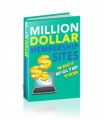 License Type: Master Resell Rights
License Type: Master Resell Rights  File Type: ZIP
File Type: ZIP
 SKU: 62670
SKU: 62670  Shipping: Online Download
Shipping: Online Download
Sample Content Preview
The 80/20 Rule Of Classic Marketing
Classic marketing is mostly geared towards the idea that 80% of sales come from 20% of top customers. That's called the 80/20 rule. That's why when you walk into two different stores in a mall, they may have slightly different merchandise, but often it is very similar. They are trying to market to the mass of people whose tastes are mainstream and easy to predict, leaving less room for variety and innovation.
In a recession, the 80/20 rule becomes so overwhelming that stores reduce their inventory into very narrow niches in order to market to the customers who are going to buy the more popular items and trends. Anything other than that is seen as a waste of display footage and an increase in rental space costs. This works well for them to keep costs down and sales up. However, that strategy also leaves a very big opportunity for online marketers to exploit the lack of diversity and novelty in mainstream retail stores by just doing the opposite: marketing to the “long tail.”
The Long Tail
The long tail is the other 80% of customers who aren't going to buy the most popular or mainstream taste items. They might need a little extra coaxing and whole lot more variety to make up their minds to part with their dollars. In a retail store, marketing to these people can take far more time, space, and money than it is worth. However, online, it is a perfect area to exploit without incurring inventory costs or having to hire additional staff.
Marketing to the long tail means that you are going to offer a much wider selection online than anyone can possibly do offline. How are you going to do that and not have to warehouse everything that may or may not sell? The answer is simple. Online, one can represent a product via an image or virtual representation that doesn't necessarily have to be directly in your inventory to sell. Instead, you just have to know where to locate it and how to get it shipped to the customer in a reasonable amount of time. That way, you can manage a very large inventory of products without having to buy them ahead of time to place them in a real, physical, inventory.
This makes it easy to offer products with a wide range of features from color choices to sizes. Now, that person that wanted that raincoat in hot pink and has searched far and wide in retail stores can hop online and instantly find it in your store. When you offer that type of variety that an offline retail store will find hard to duplicate, you gain loyal customers who will think to come to your online store first before looking elsewhere.
How Salesmanship Differs Online
Even so, you may have to coax that 80% a little more to buy your stuff. They are a picky lot who may decide to research other online stores before they buy. In classic marketing, you would have a staff person attending to that customer to find out what they need and then matching his/her need to some product or service the company sells. Online, there are no virtual sales attendants, so how are you going to guide people without having to hire someone to man a phone line?
Use Search Engine Techniques
Luckily, search engines are a major strength of the Internet and can be used in your Internet marketing techniques to not only draw people to your site, but to help them make a selection. First, put yourself in the shoes of a potential customer. If you are the lady looking for the pink raincoat, wouldn't you go to a major search engine first and put in the words “pink raincoat”? Or, if you had a specific designer in mind, you would add that word too to your search engine query. That's why it's important to use descriptive keywords and know what people are searching for to get the most hits to your sales pages from larger search engines.
This way, even if someone had no idea what your website name was and that it sold pink raincoats, you would still pop up in a search engine result page as a place to go online to find one. If you want to find out what other synonyms or terms are entered online so that you can use them within the copy of your sales page and draw eyeballs from Google, you can look up their keyword tool and look at the terms being searched online. Find a few that have low competition and are highly searchable to include in your copy, within 1 to 2% of the content of the page, and you will place higher in the search engine result pages when people go to search for those terms.
Index your pages with as many descriptive keywords as you can think of that someone might search. This is not only for the major search engines, but also to help people find things through your own search function that you’ll want to make available to customers who visit your website. The search box is going to be like your friendly salesperson. It's going to allow customers to go straight to what they want to buy and to find a listing of similar products that they might be interested in. Always include a search box as a basic strategy that markets to the long tail. Remember that these people are going to have very definite tastes and will want to have a large selection to choose from. If you don't put in a search box, they will have to first find the right product category, then the right product, and then search through them to find one in the right color, size, style, or anything else that they want. If you want to see examples of search boxes that offer just the right way to search, take a look at any major appliance manufacturer. They will normally try to take into account numerous features a person might be searching for and make it easy to find via a search box or via very well defined categories.
- License: Master Resell Rights
- Category:Ebooks
- Tags:2019 Ebooks Master Resale Rights








